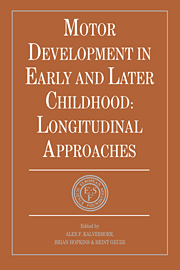Book contents
- Frontmatter
- Contents
- List of contributors
- Foreword
- Preface
- SETTING THE SCENE
- SECTION I BIOLOGICAL BASIS OF MOTOR DEVELOPMENT
- 3 Principles of early motor development in the human
- 4 Natural priorities for developmental study: neuroembryological perspectives of motor development
- 5 The ‘fixed action pattern’ concept revisited: an ethological commentary on the chapters by Prechtl and Provine
- SECTION II DEVELOPMENT OF BODY POSTURE AND GOAL-DIRECTED REACHING
- SECTION III MOTOR DEVELOPMENT, EARLY COMMUNICATION AND COGNITION
- SECTION IV ACQUISITION OF SKILLS
- SECTION V MOTOR DEVELOPMENT AND HANDICAP
- SECTION VI METHODOLOGICAL AND CONCEPTUAL CONSIDERATIONS
- Epilogue: description versus explanation
- Index
4 - Natural priorities for developmental study: neuroembryological perspectives of motor development
from SECTION I - BIOLOGICAL BASIS OF MOTOR DEVELOPMENT
Published online by Cambridge University Press: 05 May 2010
- Frontmatter
- Contents
- List of contributors
- Foreword
- Preface
- SETTING THE SCENE
- SECTION I BIOLOGICAL BASIS OF MOTOR DEVELOPMENT
- 3 Principles of early motor development in the human
- 4 Natural priorities for developmental study: neuroembryological perspectives of motor development
- 5 The ‘fixed action pattern’ concept revisited: an ethological commentary on the chapters by Prechtl and Provine
- SECTION II DEVELOPMENT OF BODY POSTURE AND GOAL-DIRECTED REACHING
- SECTION III MOTOR DEVELOPMENT, EARLY COMMUNICATION AND COGNITION
- SECTION IV ACQUISITION OF SKILLS
- SECTION V MOTOR DEVELOPMENT AND HANDICAP
- SECTION VI METHODOLOGICAL AND CONCEPTUAL CONSIDERATIONS
- Epilogue: description versus explanation
- Index
Summary
INTRODUCTION
Science is a human endeavour. Even so rigorous a physical science as physics is the behavioural record of physicists as much as it is a description of the physical world. Physicists, like all scientists, have philosophical, disciplinary and methodological biases that influence both the questions that they ask and how they interpret their results. This is not a novel insight. The realization that there can be no physics without an observing physicist led such nineteenth century physicists as H. Helmholtz to develop the discipline of psychophysics and help to found experimental psychology.
Studies of development are particularly prone to the observational biases of researchers because of their historical association with the opposed philosophical and scientific positions of nativism and empiricism in the behavioural sciences, and preformation and epigenesis in the biological sciences. In biology, the preformation–epigenesis debate was resolved decisively in favour of epigenesis when H. Driesch (using sea urchins) and later H. Spemann (using amphibians) demonstrated that each of the first two blastomeres (the two daughter cells produced by the cleavage of the zygote) was totipotent and could form a complete embryo. The dispatch of the preformationists created the problem of discovering the actual determinants of development, a search that continues to the present day. Contemporary developmentalists realize that the vertebrate embryo is not a mosaic of predetermined cell lineages. Instead, the embryo is a complex and harmonious system of cells whose developmental fate is coordinated, and in some cases determined, by a hierarchy of relationships with adjacent cells, the relative weightings of which shift with age.
- Type
- Chapter
- Information
- Motor Development in Early and Later ChildhoodLongitudinal Approaches, pp. 51 - 73Publisher: Cambridge University PressPrint publication year: 1993
- 3
- Cited by



